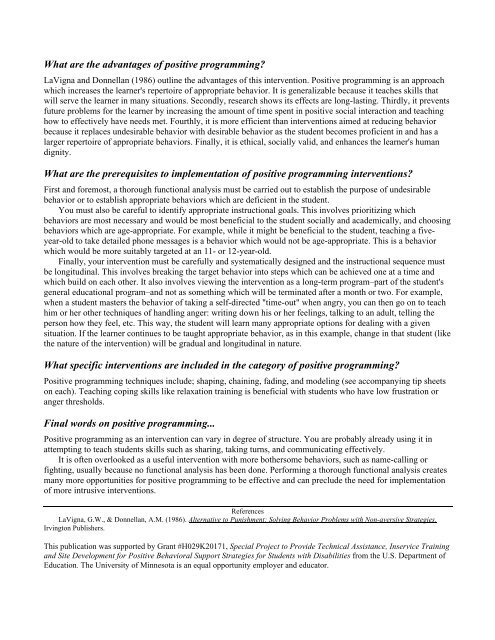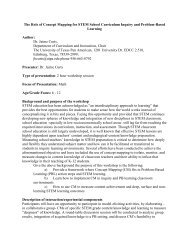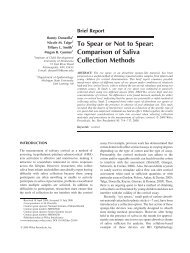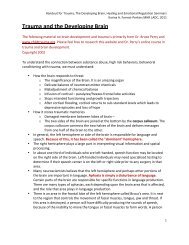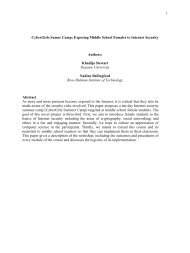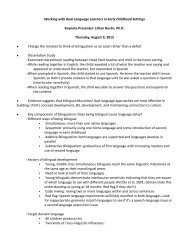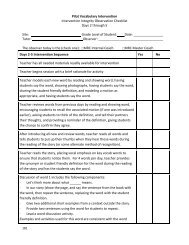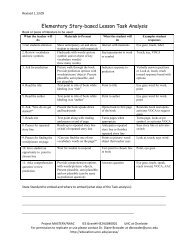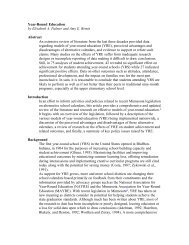Introduction to Positive Ways of Intervening with Challenging Behavior
Introduction to Positive Ways of Intervening with Challenging Behavior
Introduction to Positive Ways of Intervening with Challenging Behavior
Create successful ePaper yourself
Turn your PDF publications into a flip-book with our unique Google optimized e-Paper software.
What are the advantages <strong>of</strong> positive programming?<br />
LaVigna and Donnellan (1986) outline the advantages <strong>of</strong> this intervention. <strong>Positive</strong> programming is an approach<br />
which increases the learner's reper<strong>to</strong>ire <strong>of</strong> appropriate behavior. It is generalizable because it teaches skills that<br />
will serve the learner in many situations. Secondly, research shows its effects are long-lasting. Thirdly, it prevents<br />
future problems for the learner by increasing the amount <strong>of</strong> time spent in positive social interaction and teaching<br />
how <strong>to</strong> effectively have needs met. Fourthly, it is more efficient than interventions aimed at reducing behavior<br />
because it replaces undesirable behavior <strong>with</strong> desirable behavior as the student becomes pr<strong>of</strong>icient in and has a<br />
larger reper<strong>to</strong>ire <strong>of</strong> appropriate behaviors. Finally, it is ethical, socially valid, and enhances the learner's human<br />
dignity.<br />
What are the prerequisites <strong>to</strong> implementation <strong>of</strong> positive programming interventions?<br />
First and foremost, a thorough functional analysis must be carried out <strong>to</strong> establish the purpose <strong>of</strong> undesirable<br />
behavior or <strong>to</strong> establish appropriate behaviors which are deficient in the student.<br />
You must also be careful <strong>to</strong> identify appropriate instructional goals. This involves prioritizing which<br />
behaviors are most necessary and would be most beneficial <strong>to</strong> the student socially and academically, and choosing<br />
behaviors which are age-appropriate. For example, while it might be beneficial <strong>to</strong> the student, teaching a fiveyear-old<br />
<strong>to</strong> take detailed phone messages is a behavior which would not be age-appropriate. This is a behavior<br />
which would be more suitably targeted at an 11- or 12-year-old.<br />
Finally, your intervention must be carefully and systematically designed and the instructional sequence must<br />
be longitudinal. This involves breaking the target behavior in<strong>to</strong> steps which can be achieved one at a time and<br />
which build on each other. It also involves viewing the intervention as a long-term program–part <strong>of</strong> the student's<br />
general educational program–and not as something which will be terminated after a month or two. For example,<br />
when a student masters the behavior <strong>of</strong> taking a self-directed "time-out" when angry, you can then go on <strong>to</strong> teach<br />
him or her other techniques <strong>of</strong> handling anger: writing down his or her feelings, talking <strong>to</strong> an adult, telling the<br />
person how they feel, etc. This way, the student will learn many appropriate options for dealing <strong>with</strong> a given<br />
situation. If the learner continues <strong>to</strong> be taught appropriate behavior, as in this example, change in that student (like<br />
the nature <strong>of</strong> the intervention) will be gradual and longitudinal in nature.<br />
What specific interventions are included in the category <strong>of</strong> positive programming?<br />
<strong>Positive</strong> programming techniques include; shaping, chaining, fading, and modeling (see accompanying tip sheets<br />
on each). Teaching coping skills like relaxation training is beneficial <strong>with</strong> students who have low frustration or<br />
anger thresholds.<br />
Final words on positive programming...<br />
<strong>Positive</strong> programming as an intervention can vary in degree <strong>of</strong> structure. You are probably already using it in<br />
attempting <strong>to</strong> teach students skills such as sharing, taking turns, and communicating effectively.<br />
It is <strong>of</strong>ten overlooked as a useful intervention <strong>with</strong> more bothersome behaviors, such as name-calling or<br />
fighting, usually because no functional analysis has been done. Performing a thorough functional analysis creates<br />
many more opportunities for positive programming <strong>to</strong> be effective and can preclude the need for implementation<br />
<strong>of</strong> more intrusive interventions.<br />
References<br />
LaVigna, G.W., & Donnellan, A.M. (1986). Alternative <strong>to</strong> Punishment: Solving <strong>Behavior</strong> Problems <strong>with</strong> Non-aversive Strategies.<br />
Irving<strong>to</strong>n Publishers.<br />
This publication was supported by Grant #H029K20171, Special Project <strong>to</strong> Provide Technical Assistance, Inservice Training<br />
and Site Development for <strong>Positive</strong> <strong>Behavior</strong>al Support Strategies for Students <strong>with</strong> Disabilities from the U.S. Department <strong>of</strong><br />
Education. The University <strong>of</strong> Minnesota is an equal opportunity employer and educa<strong>to</strong>r.


